Americans shopping for a three-row family SUV in 2024 are flush with more options than ever before. But, despite all the additional entries, two models that tend to appear on most people’s shopping list have been around for a long time: the Honda Pilot and Nissan Pathfinder. Pathfinder just had its best sales year since 2017 and is gaining ground on the Pilot which sold just over 110,000 units last year. So, who wins in a 2025 Honda Pilot vs. 2024 Nissan Pathfinder battle? Well today you’re going to find out!
Pricing and Equipment
We’re going to go over all the features, performance, space, cargo and everything throughout this comparison, but as always, let’s start with a quick pricing breakdown.
To show off the best both models have to offer we have the loaded examples. For Pilot, that means the Elite trim, which after destination comes to a final price of $54,640.
Honda Pilot Elite AWD: $52,780 | Options: +$455 | Destination: $1,395 | Total: $54,640
For the Pathfinder, we have the Platinum model. It’s priced in an extremely similar way, so the final price after destination ends up at $53,960.
Pathfinder Platinum AWD: $51,520 | Options: +$350 | Destination: $1,390 | Total: $53,960
By the way, if you want to get the best price from local dealerships and access to invoice pricing info for these two models or any vehicle, we have a tool on our website to do just that. Click here for more information!
Exterior Design
We will begin here on the outside of these SUV’s. Both have been redesigned recently and have the boxier designs that are so in-fashion these days. The grilles themselves are chrome trimmed, and both have rectangular LED reflector headlights and LED DRL’s. Both also have LED fog lamps, but one noteworthy difference are the incandescent turn signals on the Nissan.
Moving to the side, both models are large, although the Pilot still has about a 2-inch length advantage overall. We will see how much this impacts the rear seats and cargo capacity later in the comparison.
Length: 199.9-inches (Pilot) | 197.7-inches (Pathfinder)
One design item I want to mention really quick is that the Pilot is now offering a Black Edition model for 2025 and the Pathfinder has the option of getting a two-tone roof design. The wheels are both 20-inch alloys.
As we head for the back, there’s not all that much to discuss at all. They follow similar design motifs, both with branding across the back, a black accent, partially LED taillights and exposed wipers. The Pilot has exposed dual exhaust outlets but the Pathfinder can tow a thousand more pounds.
Towing (max): Pathfinder: 6,000 lbs | Pilot: 5,000 lbs
Additional Features
Now checking out some of the individual features, both of their mirrors have heating, blind spot monitoring and power-folding. The only difference is that only the Pilot has auto-dimming.
Now being safe is more important than just about any of the other features, so it’s imperative to point out that both of them have all the active safety features you could want. Warranty coverage is also the same, except for Honda covering the maintenance cost for one year. HALF
Pilot: Warranties: Basic Warranty: 3yr/36k mi | Powertrain: 5yr/60k mi | Complimentary Maintenance: 1yr/12k mi
Pathfinder: Warranties: Basic Warranty: 3yr/36k mi | Powertrain: 5yr/60k mi
The inside of these two is what really counts, so now let’s move on to that.


Interior Design
Alright, let’s move into the cabins now. Approaching the SUV’s, we can check out the smart keys for the smart entry systems, and you’ll notice that they also have remote start built into them as well.
Now once we open the doors, I’ll think you’ll be surprised by just how similar they look, especially when viewed side-by-side.
But that aside, let’s talk about the seats first. We have 10-ways of adjustment, heating, ventilation and memory on both, and there are brown color options if you want something besides for the black, we have. A notable difference though is the fact that the Pathfinder has higher-grade semi-analine leather vs. real leather in the Pilot.
Now let’s climb inside and talk about the rest of the materials you will find inside. In this area, the Pathfinder has a slight advantage, since it simply is using more leatherette for the door trims and center console areas, which are areas you meet frequently.
After startup, you’ll see digital gauge clusters on both, although the Pathfinder’s is a couple inches larger than the Pilots which is borrowed from Civic.
Both of them also have head up displays, rain sensing wipers, and heated steering wheels, although it is power adjusting on the Nissan.
Storage and Technology
Another area of importance is interior storage, since these are family crossovers after all. We loaded the consoles down with donuts for our Car Confections donut test, which confirms that the Pilots console is the larger of the two at 19 vs. 24.
For other storage, both have cubbies up front with wireless phone charging pads, and then we have the passenger storage shelfs and a center passthrough which only the Nissan has.
Shifter-wise, they both have electronic style shifters and 360-degree cameras when in reverse.
Moving above, we also have 3-zone automatic climate controls, both with easy-to-use physical knobs and buttons.
And speaking of knobs, that now that brings us to the volume knobs, so let’s give the audio systems a sample. As you would probably expect, they sound very similar being of the same brand and only one speaker apart.
Pilot: 12-speaker Bose Premium sound system
Pathfinder: 13-speaker, Bose Premium Sound System
Now it’s time to look at the screens. A lot of brands have been moving to increasingly large displays, but Nissan and Honda have ignored that trend in these two thus far. The top trims of both come with 9-inch touchscreens with navigation, plus AA and ACP. Just keep in mind, both systems are wireless in the Pilot, while only ACP operates that way in the Pathfinder.
We’re thinking, or hoping at least, that both models will receive 12.3-inch screens with Google built-in for 2026 model year.
Last but certainly not least for the front of the interiors, both models have auto-dimming rearview mirrors and single-piece panoramic sunroofs.
Rear Seats and Cargo
Now heading around to the rear, I would argue that this space is even more important the front, not just for utility purposes but also because no one wants an SUV full of complaining passengers.
So first off, second row legroom. The Pathfinder has significantly less space on paper, but we independently verified with a ruler that they have nearly identical legroom & knee room in real life. The difference is likely due to different measuring methods.
- Pathfinder: Legroom: 35.5-inches | Headroom: 38.4-inches | Knee: 10-inches
- Pilot: Legroom: 40.8-inches | Headroom: 40.2-inches | Knee: 10-inches
And as far as the features back here, they have an identical list of niceties to ward off those complaints. There are rear climate controls, vents, USB ports, household power outlets, sunshades, and the seats themselves are heated.
Both also have some cool removable features. What I mean by that is that the Nissan comes with a removable center console and the Pilot comes with an even more useful removable center seat and console. This means you don’t have to choose between bench and captain chair seating in the Pilot like you have to with the Nissan.
Let’s head to the next row of seats. Both have quick and easy mechanisms to slide the 2nd rows out of place, just be aware than Nissans design would allow for a car seat to remain installed.
Remember that difference in size on the outside? Well, this is where it begins to really impact the interior because the Pathfinder’s third row legroom substantially lags behind the Honda’s, although headroom is about the same. If you’re familiar with the Toyota Highlander and Grand Highlander, that is essentially the size difference between these two. Thy support is also much better in the Pilot, which greatly impacts overall comfort.
- Pathfinder: Legroom: 28.0-in | Headroom: 37.8-in
- Pilot: Legroom: 32.5-in | Headroom: 38.1-in
Honda has one of the best 3rd rows in the segment, and it also has one of the bigger cargo holds, outside of monsters like the Grand Highlander, Atlas and Traverse. Even though smaller than those three, it’s still larger than the Pathfinder in all 3 seating configurations. Pilot overall has about 8% more cargo capacity as a maximum, but it also has over the 5% advantage threshold at all 3 configurations.
Pathfinder: Behind 3rd row: 16.6 cu.ft | Behind 2nd row: 45.0 cu.ft | MAX: 80.5 cu.ft
Pilot: Behind 3rd row: 18.6 cu.ft | Behind 2nd row: 48.5 cu.ft | MAX: 87.0 cu.ft
Both have manual folding third rows and spare tires.
That’s it for the interiors, so now let’s get them out on the streets and see how they perform behind the wheel!
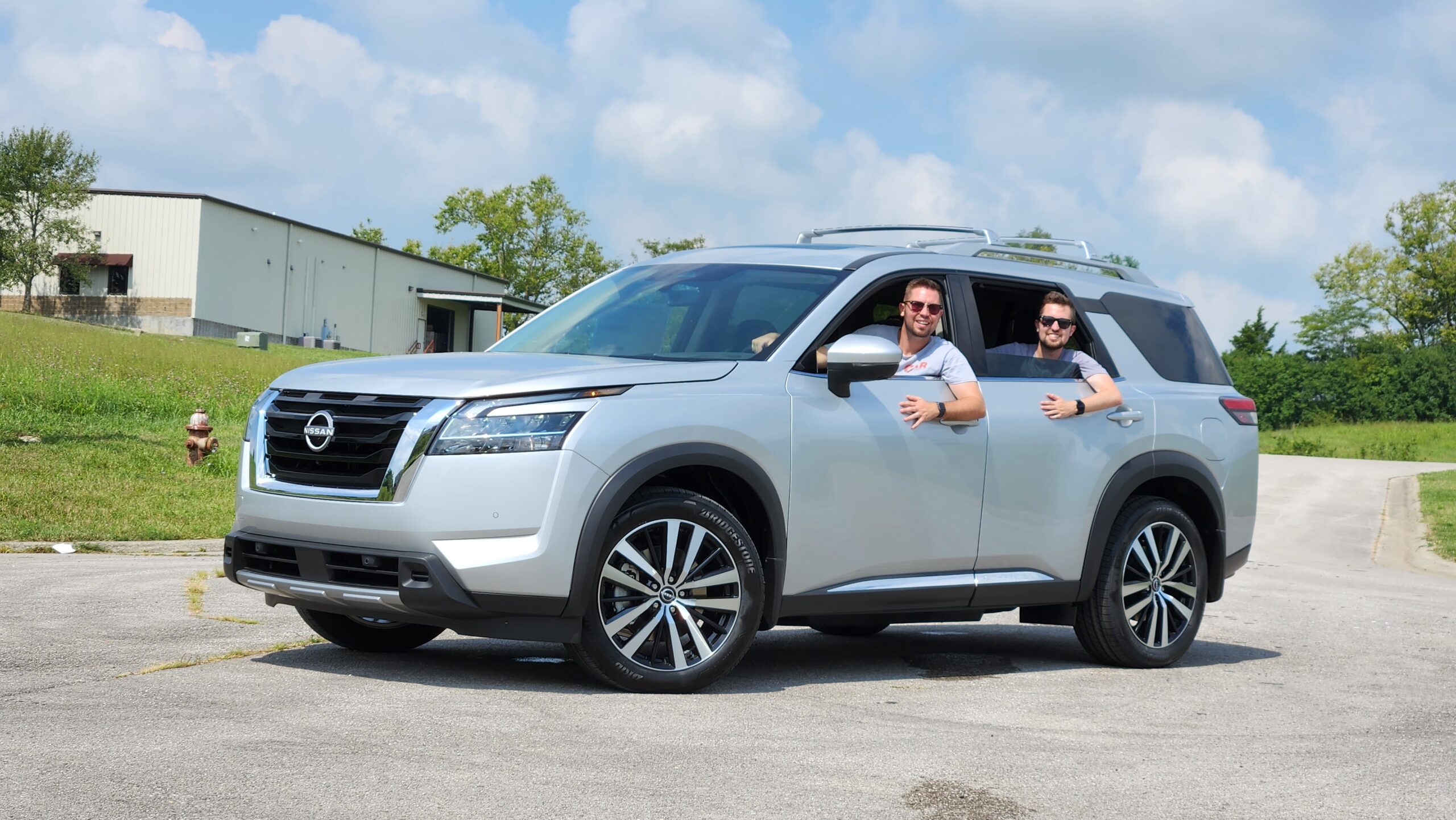
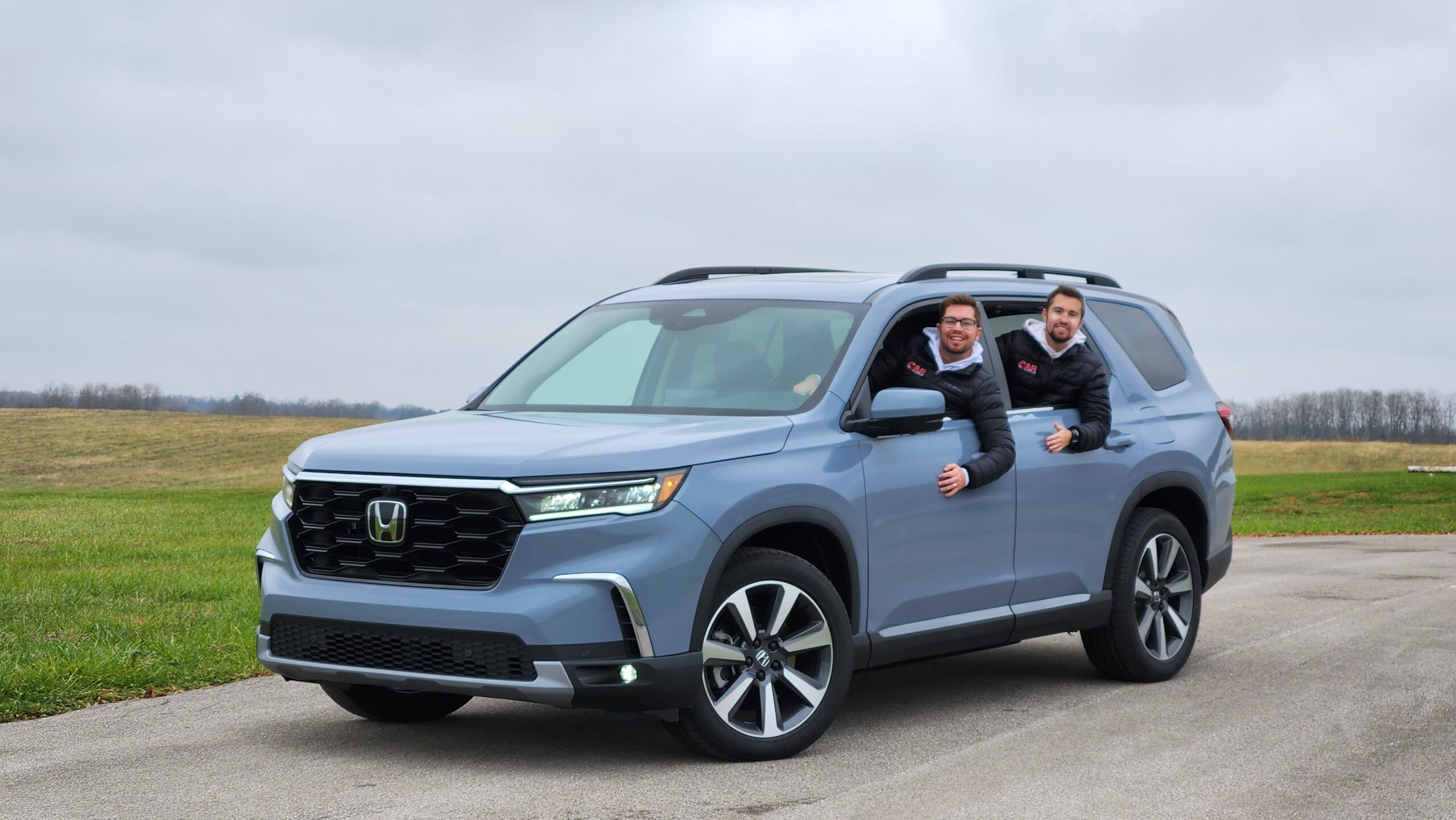
Powertrains
So, V-6 lovers rejoice because these are two family crossovers that have resisted the urge to downsize their engines thus far. Instead of turbo 4-cylinders, both Pathfinder and Pilot are rocking 3.5L V-6 engines, making almost identical power figures. As expected, this also means they accelerate very similarity.
- Pathfinder: 3.5L V6: 284 hp | 259 lb.ft
- Pilot: 3.5L V6: 285 hp | 262 lb.ft of torque
As far as the rest of the powertrains, let’s talk transmissions. Thankfully, Nissan dropped the CVT from the previous generation in favor of a 9-speed automatic and Honda switched its 9-speed for a 10-speed when they redesigned the Pilot. While having more gears doesn’t make it better, the in-house developed Honda 10-speed is smoother and more responsive than the ZF 9-speed in the Nissan. Both also have torque vectoring AWD systems.
Test Drive and Fuel Economy
Even under hard accelerations, both engines are smooth and refined, while also having powerful growls that are missing for the 4-cylinder competitors.
Speaking of a signature Car Confections element is collecting sound level readings for all the vehicles we review. When we did that, at 55 MPH, these two landed at almost the same readings. No points will be awarded here because anything less than a 1 dB difference is not considered perceivable by the average human adult.
Pathfinder: 55.2 dB @ 55 MPH
Pilot: 55.4 dB @ 55 MPH
Now speaking of smooth and refined, that perfectly describes both vehicles ride qualities. They absorb all but the largest road imperfections and emphasize comfort. Handling-wise, the Honda has the better body control when cornering which makes it feel like a smaller vehicle.
And lastly, for fuel economy, both are rather unremarkable compared to 4-cylinder or hybrid rivals. Fuel economies are 21 and 22 combined, with no alternative powertrain options currently.
- Pathfinder AWD: 20/25/22 MPG
- Pilot AWD: 19/25/21 MPG
Resale and Reliability
In our reviews and comparisons, we are also adding in reliability and resale information to give you a better picture of the overall value beyond just the original MSRP.
Beginning with reliability, we developed the Combined Reliability Index, which considers several studies from trustworthy sources, and combines them in a way that gives a more realistic picture. Honda ranks 14 slots ABOVE the industry average for all brands in reliability, while Nissan is slightly below industry average reliability.
We also put Mason’s economics degree to work to develop a detailed Predicted Resale Value tool. After 5 years and 60,000 miles, both brands get pretty good results, but Honda is better. Honda actually has the very highest predicted resale value of 64.8% and Nissan comes in at 50.5%.
Resale is obviously important because it determines how much money you get back, but we can’t forget about the price difference at the original purchase. The Pilot costs $680 more than the Pathfinder.
I want to emphasize that if money, reliability or resale value matter less to you personally, feel free to disregard these points. And if you’d like to check out all our data about reliability and resale values, as well as learn about our methodology, make sure to head to www.carconfections.com/resale and www.carconfections.com/reliability. Buying a car is a big decision, and this is a great place to compare all the makes you might be cross-shopping.
2025 Honda Pilot vs. 2024 Nissan Pathfinder winner!
So, there you have it; these two fought hard and the real winner are the customers that get so many great options to pick from in this class. But, nevertheless, let’s discuss who should be “your” personal winner:
Pilot:
- Bench/captain chair on demand
- Better predicted resale and reliability
- More spacious
Pathfinder:
- Semi-analine leather seats and other materials
- Power-adjusting steering wheel
Now we want to know your opinions, so make sure to head to the comment section and let us know which one you would pick!
Thanks for joining us for another Car Confections Comparison! We’ll catch you next time as we sample the latest automotive delicacies!
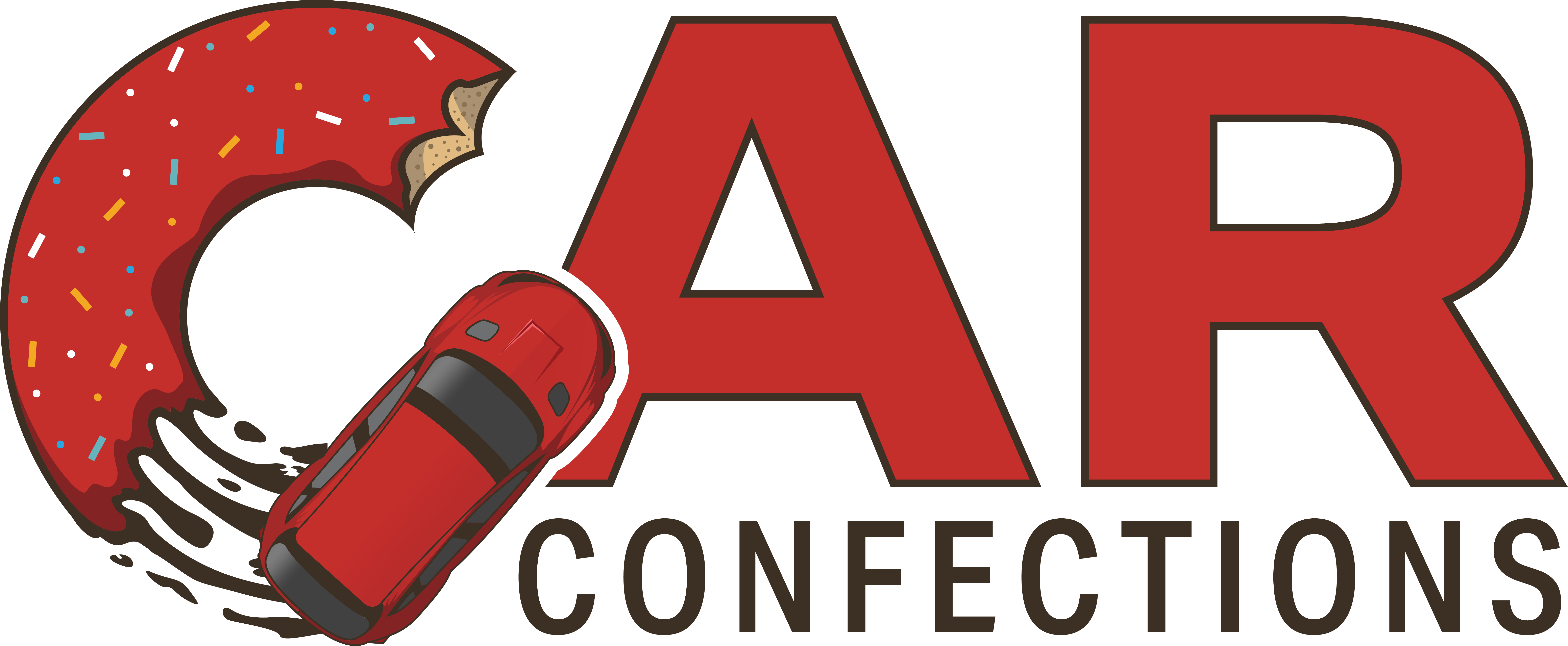
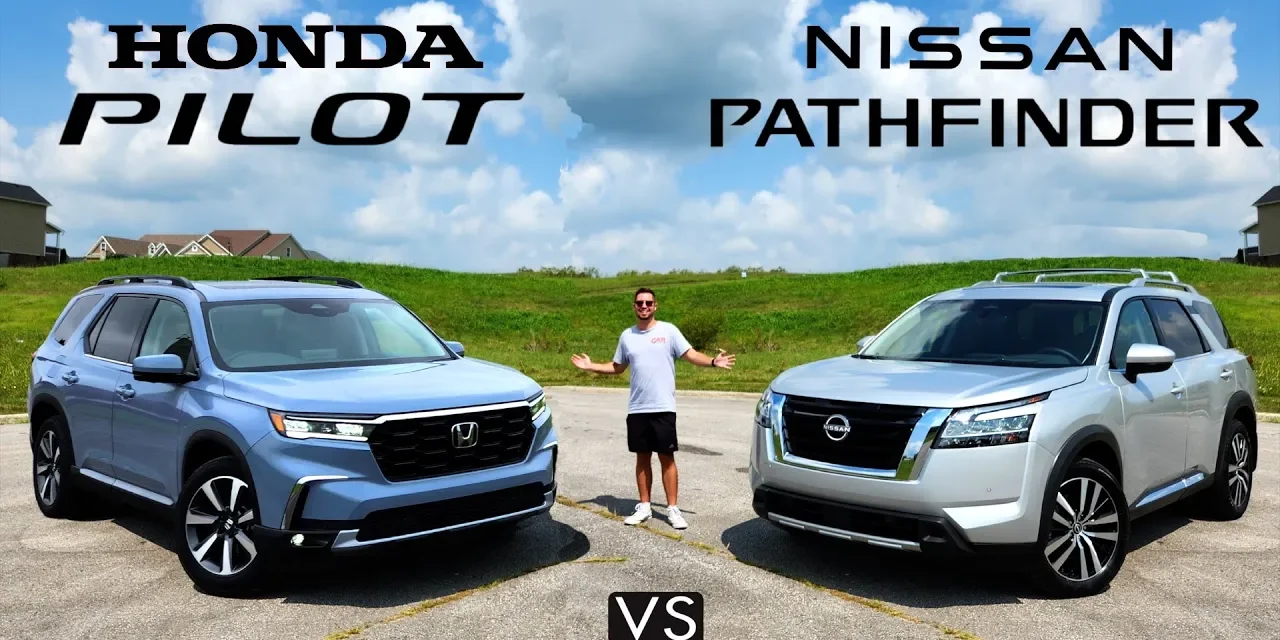



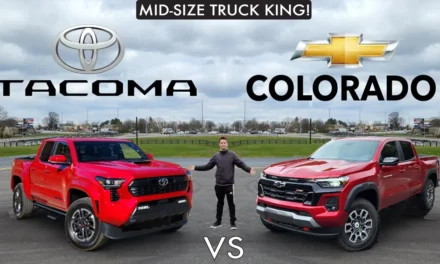






Recent Comments